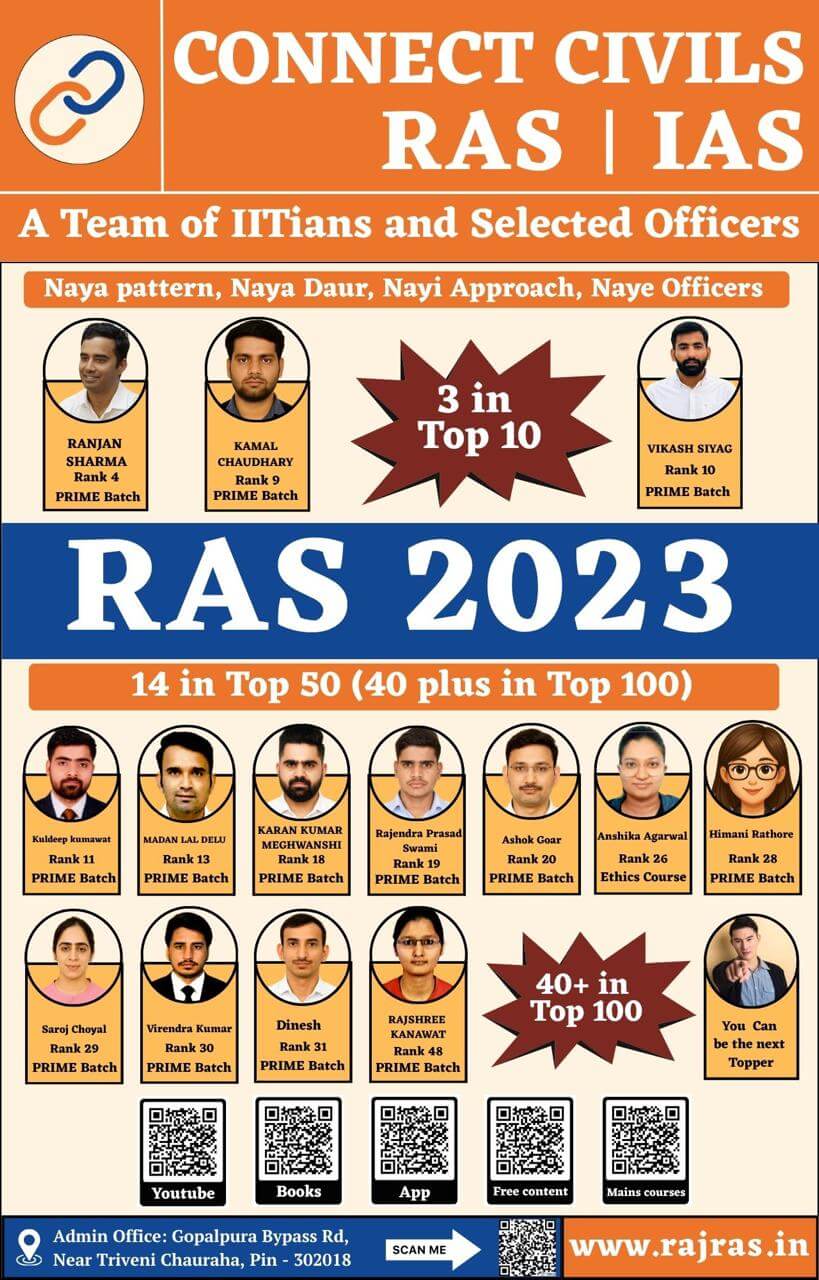Click here to download the schedule – English Medium | Hindi Medium
Subject – Management
Topic – Wealth Maximization, Sources of Finance – Short and Long Term, Capital Structure, Cost of Capital, Distribution of Profit; Banking and Non – Banking Financial Institutions (NBFIs), Stock Market, Multi-National Companies (MNCs), Foreign Direct Investment (FDI), Foreign Institutional Investment (FII), Leadership Theories and Styles, Group Behaviour, Individual Behaviour; Attitude, Values, Team Building; Motivation Theories, Conflict Management, Time Management, Stress Management, Training, Development and Appraisal Systems
For Hindi medium – Click here
Management PYQs – Click Here
Click on the question to see the model answer. Submit your answers below and complete the 90-day challenge for RAS Mains answer writing
Q1. Differentiate between training and development.(2M)
Answer:
| BASIS | TRAINING | DEVELOPMENT | |
| 1. | Concept | Indicates the process by which attitudes, skills and abilities of employees to perform specific jobs are increased. | Development refers to the learning opportunities designed to help employees grow. |
| 2. | Nature | It also includes those activities which bring about growth of the personality, help individuals in the progress towards maturity and actualisation of their potential capacities so that they become not only good employees but better men and women | It also includes those activities which bring about growth of the personality, help individuals in the progress towards maturity and actualization of their potential capacities so that they become not only good employees but better men and women |
| 3. | Focus/Purpose | It is job oriented process | It is career oriented process |
| 4. | Time | It is a short-term process. | It is an ongoing process. |
| 5. | Centered | It is work centered. | It is person-centered. |
Q2. Explain McGregor’s Theory X and Theory Y briefly.(5M)
Answer:
Douglas McGregor’s Theory X and Theory Y are contrasting views of human nature and employee motivation. They represent different assumptions about how people inherently view work and how they should be managed in the workplace:
| Aspect | Theory X | Theory Y |
| Assumption | Assumes that people are generally lazy, dislike work, lack ambition, and are primarily motivated by external rewards and punishments. | Assumes that work is natural and can be fulfilling; individuals are capable of self-motivation, self-control, and enjoy being creative. |
| Management Style | Authoritarian, with close supervision and control | Participative, encourages employee involvement in decision-making |
| Communication | Top-down, decisions made by higher-ups without much employee involvement. | Open and two-way communication, fostering collaboration. |
| Leadership Belief | Employees prefer to be directed, need constant supervision, and coercion to work effectively. | Employees can be ambitious, seek responsibility, and make significant contributions with the right conditions. |
These theories serve as conceptual frameworks for understanding managerial attitudes towards employees and influence organizational approaches to leadership, motivation, and management practices. They were introduced by Douglas McGregor in his book “The Human Side of Enterprise” published in 1960.
Q3. Highlight the major differences between Foreign Direct Investment (FDI) and Foreign Institutional Investment (FII).(5M)
Answer:
| Feature | Foreign Direct Investment (FDI) | Foreign Institutional Investment (FII) |
| Nature of Investment | Long-term investment to establish control or significant influence over a company. | Short to medium-term investment with a focus on portfolio investment in financial assets. |
| Purpose | Strategic investment to participate in the management and operations of the invested entity. | Primarily seeks financial returns and capital gains through buying and selling securities. |
| Level of Control | Generally seeks a substantial level of control or influence over the management and decision-making of the invested entity. | Does not seek control over the management or day-to-day operations of the invested companies. |
| Investment Duration | Involves a long-term commitment, often with a horizon of several years. | Can involve frequent buying and selling of securities, leading to shorter investment durations. |
| Sector Focus | May be directed toward various sectors, including manufacturing, infrastructure, and services. | Often focuses on equity and debt instruments in financial markets, such as stocks and bonds. |
| Risk and Return | Involves a higher level of risk due to the long-term commitment and exposure to operational and economic risks. | Typically involves market-related risks, and returns are influenced by changes in stock and bond prices. |
| Role in the Economy | FDI is seen as contributing to economic development by bringing in capital, technology, and managerial expertise. | FIIs contribute to market liquidity, but their impact on economic development is indirect and depends on market conditions. |
| Regulatory Approval | Requires regulatory approvals and compliance with local laws and regulations. | Generally subject to market regulations, with fewer restrictions on entry and exit. |
| Influence on Exchange Rates | Can impact exchange rates, especially if it involves substantial capital flows. | May cause short-term fluctuations but tends to have a less significant impact on exchange rates compared to FDI. |
| Examples | A foreign company establishing a manufacturing plant in another country. | Foreign institutional investors buying shares in the stock market of another country. |
Q4. सचिव, राजस्थान पाठ्यपुस्तक मंडल, अजमेर की ओर से एक विज्ञप्ति लिखें, जिसमें पुस्तक-विक्रेताओं को पंजीकरण कराने का उल्लेख हो।
Answer:



